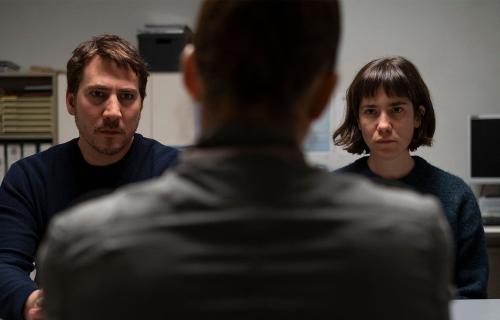
In FUNERAL PARADE OF ROSES focust Japans experimenteel filmmaker Toshio Matsumoto op een chaotische driehoeksverhouding in Bar Genet in Tokyo. De exuberante 1960s esthetiek verbindt popart met Bertolt Brecht en deze prachtig gerestaureerde cultfilm toont een onbeschaamd portret van een undergroundgemeenschap van dragqueens binnen het Japanse nachtleven.
"Funeral Parade of Roses explores both the visible and invisible realities of Japan in the transnational period of the late 1960s. On the one hand it documents the youth rebellion of that time of which itself was a part; on the other hand, allegorically, it communicates what Matsumoto calls the “deep sense of depression of the era”. However, he explores not only these sociocultural realities of Japan in the late 1960s, but by merging documentary style and avant-garde convention his work also critically investigates the reality of cinema both as a medium of representation and as an art. Moreover, as Hall suggests, Matsumoto uses the Oedipus story as a structure to implant his own expressive (and oppositional) impulse. In this respect, Funeral Parade of Roses may be seen, as Matsumoto suggests, as an implementation of his own art (or film) theory by linking the facticity of filmmaking with more challenging dimensions of homosexual underground culture, as well as by exploring what he calls “the objective reality, the world of expression, and the filmmaker’s subjective manipulation.”
Mika Ko in: Screen, Vol. 52, nr. 3, Autumn 2011, p. 389-390"In the broadest terms, the city symphony is a film that portrays the life of a city from morning to night. […] While canonical city symphonies tend to privilege triumphant, panoramic views of the urban landscape, Funeral begins by showing a couple making love. The camera captures their movements- hands grasping at a back, lips kissing, a face buried in the crevice beneath the ribs- in shots alternately close-up and so extremely close-up as to render the mise-en-scene abstract. The scale in this sequence is so skewed, in fact, that the bodies begin to resemble landscapes. Overexposed to the point of being nearly white, the sequence ends with a close-up shot of Eddy, the young transvestite from the drag bar Genet, in rapture as his older lover, Gonda, kisses his neck. Unlike a typical city symphony, by opening with images of a sexually intimate act, Funeral focuses on rather than omits ‘the multiplicity of the human landscape,’ as Juan Suarez argues […] Not only does Funeral focus on the human landscape, as it were, it also shows, in the following scene in Gonda’s car, that subjectivity is inextricably tied to the social space of the city. In a shot which tightly frames the rearview mirror so that it takes up the centre third of the frame, Eddy’s eyes, which are reflected in the mirror, are sandwiched by the overexposed receding cityscape behind them. Showing Eddy in a moment of uneasy silence, the shot suggests the he will be defined through his relation to the city as well as to other people."
Taro Nettleton in: Screen, Vol. 55, nr. 1, Spring 2014, p. 9-10"Matsumoto rejects the idea that the camera can capture everything about an event, an object or person. His position stems from his infatuation with the film Guernica (1951) by Robert Hessens and Alain Resnais, who chose not to show Picasso’s painting in its entirety, instead presenting a series of close-ups that split the work into pieces. In Matsumoto’s eyes, this decision leads the film to achieve a truthful representation of the painting as it reaches into its inner world to share its ‘ontlogical condition’. Guernica became the catalyst for the young Japanese critic and filmmaker to devise his theory of ‘avant-garde documentary’, which sought to rejuvenate both documentary and avant-garde (particularly surrealist) film by collapsing the boundaries between subjectivity and the exterior world. Funeral Parade of Roses sees Matsumoto diving into this gap by blending documentary scenes and explicitly avant-garde techniques into Eddie’s story, which gradually unravels into a gender-twisted retelling of the Oedipus myth."
Julian Ross in: Sight and Sound, Vol. 30, nr. 6, Summer 2020, p. 30



